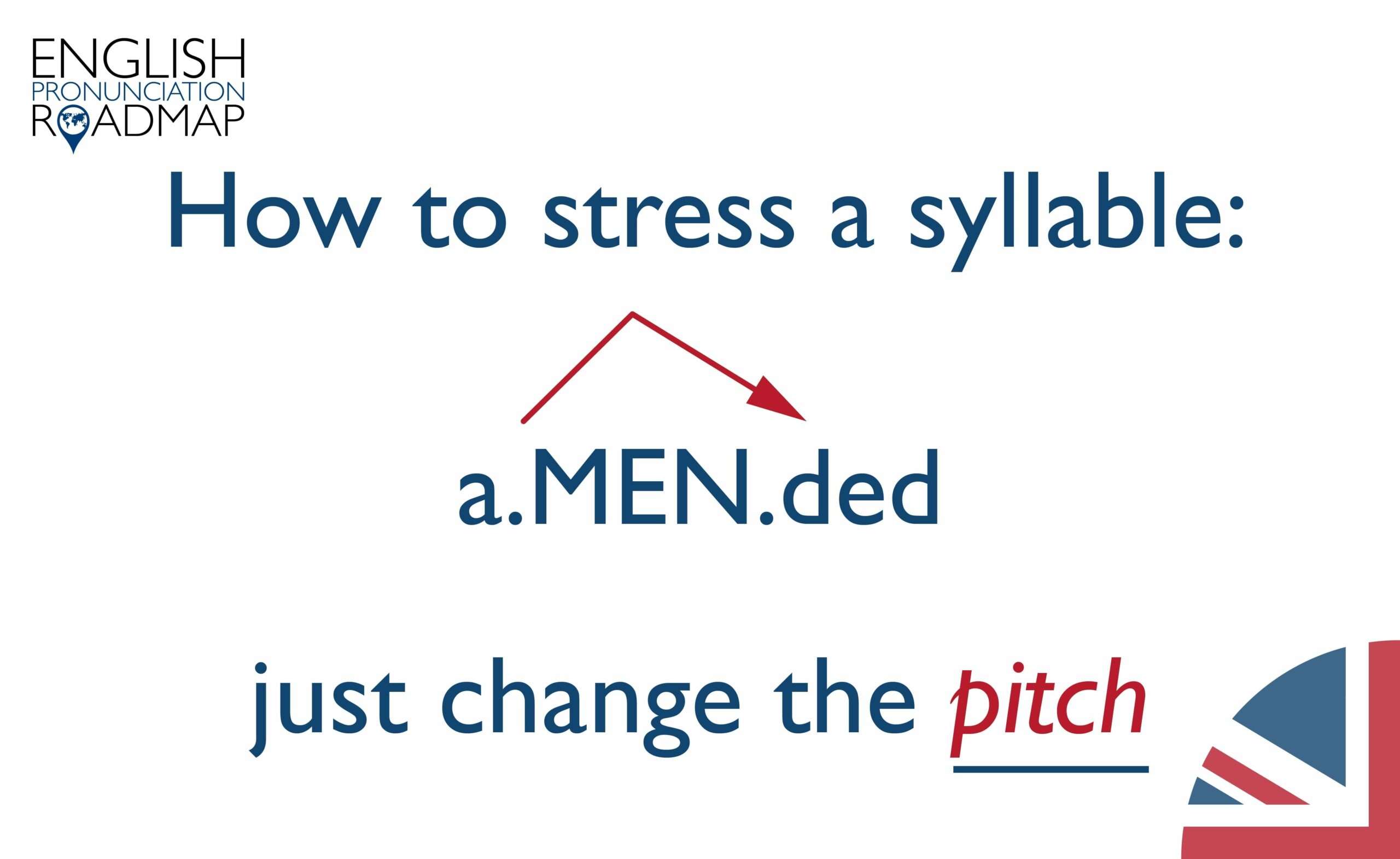What is a stressed syllable?
If you want to find out more about syllables in English, how to count syllables, how to divide syllables or stress in english intonation then this syllables lesson is for you.
Last week I was talking to you about rhythm and stress in english intonation and specifically how speaking in a stress timed rhythm would help you to sound much more confident and much more at ease speaking British English. So be sure to check out my channel and find out more about word stress in British English.
And as a part of the video I mentioned syllables and I said if you don’t know what a syllable was that you should go onto Google and check it out and it would give you the answer and I thought well maybe I should make you a video about syllables and so this is what I am doing and I’m gonna talk about syllables and the number of syllables in words but more importantly and more relevant how to stress those syllables in words in British English.
So here goes…
What is a syllable?
And what is a stressed syllable?
A syllable is essentially a single unit of speech and that unit of speech tends to contain a vowel sound and that may have a consonant after it or before it, it may even have what is called a cluster of consonants, which means more than one consonant before it or after it. That’s a pretty standard definition of syllable.
So for instance ‘at’ is a single syllable. It happens to be a word but it’s a single syllable word; to’, ‘if’, ‘a’, so these are single syllable words in another name for those are mono-syllabic words and here are a few more:
- at
- to
- bit
- can
- bite
- stack
- thwart
- click
- our
- or
- are
Stressed, Unstressed, and Secondarily-Stressed Syllables
Spoken English follows a loose, rhythmic pattern of soft beats. Stressed syllables form the underlying basis of that rhythm. Unstressed and secondarily-stressed syllables are necessary off-beats that fill the space between stressed syllables in spoken English.
Stressed syllable dictionary notation / ˈ/
When a word has more than one syllable, a single syllable within the word is given more emphasis than any of the other syllables. That syllable is considered to be the stressed syllable. The vowel sound of the stressed syllable is emphasized by being pronounced longer, louder, and often at a higher pitch than the surrounding syllables. Vowel sounds of stressed syllables are more likely to be phonetic (pronounced as the spelling would suggest).
The symbol / ˈ/ is used to represent the stressed syllable of a multi-syllable word.
Unstressed syllables and schwa notation /ə/
Within a multi-syllable word, an unstressed syllable is frequently located next to a stressed syllable. Often, this vowel sound is not phonetic (not pronounced the way it is spelled), and is instead pronounced with a quick, neutral vowel sound called schwa. Because schwa is a function of syllable stress and not spelling, schwa can have almost any spelling.
In dictionary transcriptions, the vowel sound schwa is represented with an upside-down e: /ə/.
Secondarily-stressed syllable dictionary notation / ˌ /
Secondarily-stressed syllables most often occur two beats off a main stress. They are given more emphasis than unstressed syllables, but not as much as a stressed syllable. Secondarily stressed syllables are more likely to be pronounced phonetically than unstressed syllables.
The symbol / ˌ / is used to represent secondarily-stressed syllables of a multi-syllable word.
Representing syllable stress with dots:
●
• 🌑
Along with the symbols for stressed and secondarily-stressed syllables, dots are used to show the rhythm of spoken English stress patterns. A large dot represents a stressed syllable, a medium dot represents a secondarily-stressed syllable, and a small dot represents an unstressed syllable.
comˈpete
• 🌑
Words are made up of letters and those letters create syllable sounds. You can recognize a syllable by remembering that each one contains a vowel sound. For example, in the word computer, there are three syllables: com / pu / ter. The word bike, however, has only one syllable. A single syllable may contain as little as just one letter, or as many as five:
idea – i / de / a (three syllables)
cough – cough (one syllable)
In words that have more than one syllable, one syllable will be stressed. In English, there are a number of word syllable stress patterns.
Counting Syllables
You can check how many syllables a word has by putting your hand under your chin and saying a word. Each time your chin moves to make a vowel sound, count a syllable. For example, the word difficult moves your chin three times. Therefore, difficult is three syllables.
Exercise
Count the number of syllables in each of these words. Answers are below.
- house
- jacket
- glasses
- encyclopedia
- employer
- information
- troublemaker
- thought
- happy
- incoherent
Answers
- 1 (house)
- 2 (ja / ket)
- 2 (gla / sses)
- 6 (en / cy / clo / pe / di / a)
- 3 (em / ploy / er)
- 4 (in / for / ma / tion)
- 4 (trou / ble /ma / ker)
- 1 (thought)
- 2 (ha / ppy)
- 4 (in / co / her / ent)
Word Syllable Stress
In multi-syllable words, the stress falls on one of the syllables. The other syllables tend to be spoken quickly. This leads to sounds that are not clear (muted) on unstressed syllables. In order to improve your pronunciation, focus on pronouncing the stressed syllable clearly. However, don’t be afraid to mute (not say clearly) the other unstressed vowels.
For example:
Listen to these specific examples. Notice where the syllables are stressed:
- PersonNEL
- TOtally
- InDUstrial
- ToMAto
- FanTAstic
One Syllable – Stressed
All one-syllable words have the stress on the one syllable. The intonation should go down.
Listen to the general pattern.
- EAT
- DRINK
- SIGN
- WELL
Two-Syllable
First Syllable Stressed
Listen to the general pattern and these specific examples:
- GIant
- PICture
- HEAting
Second Syllable Stressed
Listen to the general pattern and these specific examples:
- toDAY
- aHEAD
- aLLOW
Three-Syllable
First Syllable Stressed
Listen to the general pattern and these specific examples:
- ENergy
- Operate
- ORganize
Second Syllable Stressed
Listen to the general pattern and these specific examples:
- meMORial
- aSSUMPtion
- caNAdian
Third Syllable Stressed
Listen to the general pattern and these specific examples:
- employEE
- japanESE
- voluntEER
Four-Syllable
Second Syllable Stressed
Listen to the general pattern and these specific examples:
- psyCHOLogy
- eVAporate
- cerTIficate
Third Syllable Stressed
Listen to the general pattern and these specific examples:
- poliTIcian
- indiVIdual
- repuTAtion
Double Vowel Sounds
It’s not the number of letters that make up a syllable, rather it is the number of single vowel sounds. Sometimes, a number of vowels combine to make just a single sound. For example:
tree = 1 sound
goal = 1 sound
because = 1 sound
Common Double Vowel Sounds
It’s important to learn spelling patterns for these sounds. Here are some of the most common:
ay – (diphthong EI sound) play, say, may
au – (long A sound) fault, launch, haunt
augh – (long A sound) caught, taught, daughter
augh – (short A sound as in “cat”) laugh
ee – (long EE sound) tree, see, three
ea – (long EE sound) each, peach, teach
ea – (short E sound) dead, head, health
ea – (long EE sound) break, steak, great
eu – (long U sound) deuce, sleuth
ei – (diphthong EI sound) beil, eight, weigh
ey – (diphthong EI sound) they, grey
eigh – (diphthong EI sound) eight, freight
eigh – (long EE sound) seize
eigh – (diphthong AI sound) height
ie – (long EE sound) thief, pice
ie – (long I sound) die, tie
oo – (long U sound) moo, boo
oo – (short U sound) book, foot
oa – (long O sound) boat, moat
oe – (long O sound) hoe, Joe
oi – (diphthong OY sound) soil, toil
ou – (long O sound) soul, your
ou – (short U sound) tough, rough
ue – (long U sound) cue, muse
ui – (long U sound) fruit, juice
Schwa for Unstressed Syllables
Unstressed syllables keep the correct sound, but are muted. Sometimes, unstressed vowels become a schwa sound - like a soft uh sound.
Listen to these specific examples:
- Little
- Repeat
- Tomato
At other times, the vowel is pronounced but not stressed. Listen to these specific examples:
- Industrial
- Noisily
Generally speaking, stressed syllables retain a clear vowel sound, while unstressed syllables tend to soften towards a schwa-like sound.
Now that we have reviewed the various sounds of English, we must discuss syllable and word stress or another way to put it, the rhythm of English. It is important to keep in mind that English is a time-stressed language. As opposed to Spanish, which is a syllable-timed language in which an equal amount of time is given to each syllable, English adjusts the timing of stressed and unstressed syllables and words. In English, some syllables are longer and some shorter. By stressing certain syllables and words, we can better understand the meaning of the word or sentence. Understanding time stress and intonation in English will help the learner both better understand English and be better understood.
Syllable Stress
Words are made up of syllables. Syllables are units of sound which almost always have, with few exceptions, at least one vowel sound. In words of two or more syllables, one syllable is stressed while the others are said quickly and without emphasis.
The only fixed rules for syllable stress are: 1) words can only have one stress and 2) the stress is always on a vowel.
Interestingly, related words can have different syllable stresses (PHOto, phoTOgrapher, photoGRAPHic) and the stress pattern of homographs change their meaning (see note below). For the moment, what’s important is to understand what we mean by syllable stress and to recognize the different syllable stress patterns in English.
Note: Some dictionaries indicate the stressed syllable of a word with an apostrophe (’) either before or after the stressed syllable. In the examples below, the apostrophe is located before the stressed syllable.
One Syllable: Stressed
One syllable words logically have the stress on the one syllable.
Examples:
PAY
/’peɪ/
DRIVE
/’draɪv/
GOOD
/’gʊd/
Two Syllables: 1st Syllable Stressed
In most two syllable nouns and adjectives, the first syllable is generally stressed.
Examples:
SWIMming
/’swɪmɪη/
APple
/’æpəl/
HAPpy
/’hæpi/
LITtle
/’lɪtl/
Two Syllables: 2nd Syllable Stressed
Two syllable verbs are normally stressed on the second syllable.
Examples:
beGIN
/bɪ’gɪn/
deSERVE
/dɪ’zɜ:rv/
aGREE
/ə’gri/
Note: Understanding syllable stress is important not only for pronunciation, but also for comprehension because placing the stress on different syllables can change the meaning of a word (homographs). There are many two syllable words whose meaning can change depending on which syllable is stressed. For example, when the stress is on the second syllable of the word “desert” (deSERT), it is a verb meaning to abandon. On the other hand, if we change the stress to the first syllable (DEsert), it is a noun which means an arid place.
Examples:
DEsert
/’dezərt/ (noun)
deSERT
/dɪ’zɜ:rt/ (verb)
CONtract
/’kɑ:ntrækt/ (noun)
conTRACT
/kən’trækt/ (verb)
OBject
/’ɑ:bʤɪkt/ (noun)
obJECT
/əb’ʤekt/ (verb)
Three Syllables: 1st Syllable Stressed
Most three syllable words (nouns, adjectives or verbs) are stressed on the first syllable. Three syllable words terminating with the “-er”, “-or”, “-ly” or “-y” are generally stressed on the first syllable.
Examples:
ENergy
/’enərʤi/
FInally
/’faɪnli/
HOSpital
/’hɑ:spɪtl/
BEAUtiful
/’bju:təfəl/
ORganize
/’ɔ:rgənaɪz/
Three Syllables: 2nd Syllable Stressed
Words ending in “-tion”, “-sion”, “-ic” or “-al” among other suffixes, generally have the stress on the syllable found before these terminations. This is the case for both three and four syllable words.
Examples:
conSUMPtion
/kən’sʌmpʃən/
deNIal
/dɪ’naɪəl/
oFFENsive
/ə’fensɪv/
Three Syllables: 3rd Syllable Stressed
Words with the following suffixes have the stress on the final syllable (the suffix): “-ee”, “-eer”, “-ese”, “-ette” or “-ique”.
Examples:
refeREE
/refə’ri:/
engiNEER
/enʤə’nɪr/
Four Syllables: 2nd Syllable Stressed
The stress in four syllable words is either on the second or third syllable. The second syllable is generally stressed if the word ends in “-cy”, “-ty”, “-phy”, “-gy” or “-al”.
Examples:
dePENdency
/dɪ’pendənsi/
psyCHIatry
/sə’kaɪətri/
eQUALity
/ɪ’kwɑ:ləti/
Four Syllables: 3rd Syllable Stressed
Words ending in “-tion”, “-sion” or “-ic” generally have the stress on the syllable found before these terminations. As notes above, this is the case for both three and four syllable words.
Examples:
poliTIcian
/pɑ:lə’tɪʃən/
eduCAtion
/eʤə’keɪʃən/
unreaLIStic
/ʌnri:ə’lɪstɪk/
Compound Words
The stress in compound words depends on whether the word is a noun, adjective or verb. Compound nouns take the stress on the first word, adjectives and verbs on the second.
Examples:
Compound nouns
AIRplane
/’erpleɪn/
TOOTHbrush
/’tu:ɵbrʌʃ/
Compound adjectives
new
AGE
/nu: ’eɪʤ/
Compound verbs
deTEST
/dɪ’test/
underSTAND
/ʌndər’stænd/
Phrasal Verbs
Phrasal verbs always have the stress on the second word or the preposition. As we will see below, this is an exception to the rules for sentence stress, where the stress is generally on the principle verb.
Examples:
wake UP
/weɪk ’ʌp/
work
OUT
/wɜ:rk ’aʊt/
get
OFF
/get ’ɔ:f/



